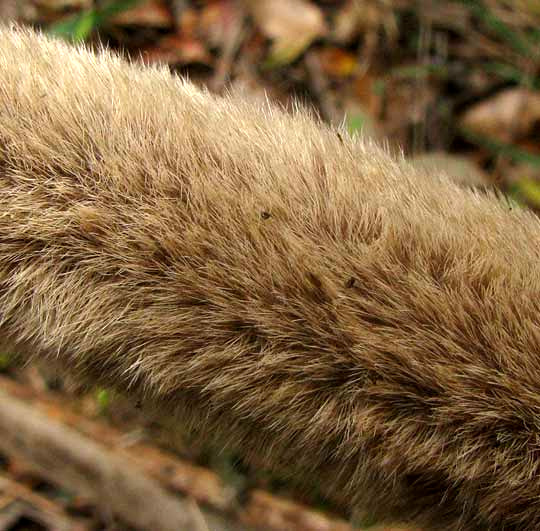Excerpts from Jim Conrad's
Naturalist Newsletter
from the November 24, 2013 Newsletter issued from the Frio Canyon Nature Education Center in the valley of the Dry Frio River in northern Uvalde County, southwestern Texas, on the southern border of the Edwards Plateau; elevation ~1750m (~5750 ft); N29.62°, W99.86°; USA
ANTLER VELVET
The valley of the little Dry Frio River is overpopulated with deer. Mostly there's native White-tailed Deer, but also Axis Deer from Asia are very common, and from time to time you see European Red and Fallow, and other deer and deer-like species escaped from local ranches who sell hunting rights for shooting "exotic game."
Most of my car-driving neighbors have hit one or more deer, and it's common to see dead deer beside the road. This week a large male, six-point Axis Deer has been decaying along my jogging route. I was interested in the thick "velvet" covering his antlers, a small portion of which can be seen below

Antler velvet is hairy skin, not just hairs, covering actively growing antlers. Antlers are regarded as the fastest growing of all mammal bones, which explains why antler velvet skin is so richly supplied with blood veins, which supply oxygen to the antlers. Once an antler has reached full size its velvet is lost and the antler bone dies, resulting in the mature antler.
Mature bucks whose antlers have stopped growing spend a lot of time and energy scraping their antlers on the trunks of young trees, removing the velvet. The scraping often severely damages or kills the tree. Hunters look for such trees, calling them "buck rubs."
If you Google the keywords "deer antler velvet," mostly you get links to businesses selling deer antler velvet, because deer antler velvet is big business. New Zealand ships tens of millions of dollars worth of velvet to Asia and the US each year. A National Geographic page refers to deer antler velvet as "essentially a growth hormone called 'insulin-like growth factor 1,' or IGF-1."
Growth hormones are given to young people with stunted growth, but the main use of them nowadays seems to be by athletes and bodybuilders because some research shows that IGF-1 may be effective in healing certain cartilage and tendon injuries. Deer antler velvet, being natural and for thousands of years used by various cultures for various purposes, is an unregulated source of IGF-1. Still, IGF-1, thus deer antler velvet, is on the National Football League's list of banned substances.